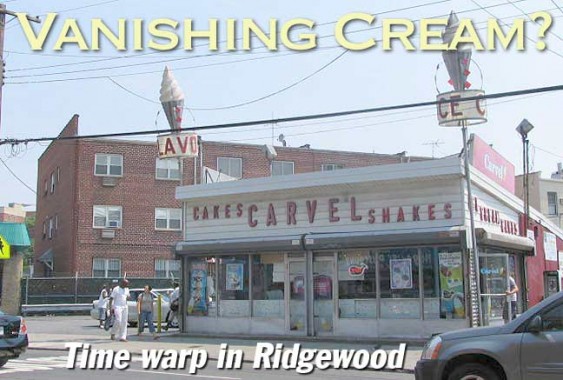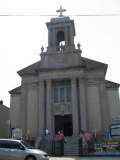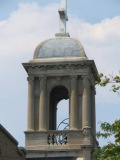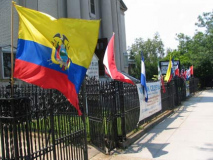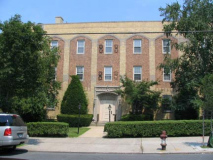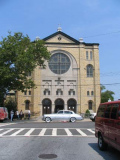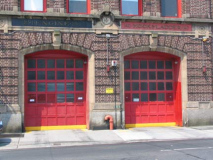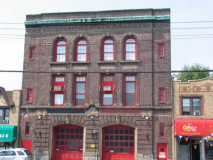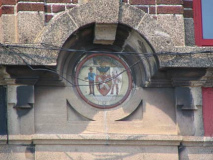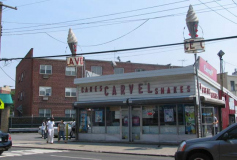There are some neighborhoods in NYC like Williamsburg, Greenpoint and the Lower East Side that are seemingly changing by the hour, if not the minute. There are others that are apparently changing more slowly — if not for the better — like Flushing and Astoria. And then there are the neighborhoods that look exactly the same as they did 20, 30, 40 years ago if not longer.
True to the ForgottenSlice credo today we’ll take a look at a couple of blocks in Ridgewood in which the photos were done in mid-July 2007, but many could just as well have been snapped in 1967 or 1977…
The United Presbyterian Church of Ridgewood, 62-54 60th Place (just south of Metropolitan Avenue), which has an exquisite Ionic-columed campanile, was built in 1909, though there has been a congregation here since 1863. It presently holds services in English, Spanish and Korean, and the flags of many nations fluttered on the outside fence the day I was by, including that of Ecuador.
In Ridgewood you are never far from a church; just a couple of blocks from United Presbyterian is the Roman Catholic Our Lady of the Miraculous Medal, seen from Bleecker Street (left) and its parish house on 60th Place (right).
This church takes its name from a chapel in Paris, France, where Catholics believe that the Virgin Mary appeared to Zoe (Catherine) Labouré in 1830, and requested the production of a medal, saying: “Have a medal struck upon this model. Those who wear it will receive great graces, especially if they wear it around the neck.” Today there are billions of Miraculous Medals worldwide.
A classic firehouse at Metropolitan Avenue west of Forest, Engine 291/Hook & Ladder 140, has been here since 1915.
Terrific brick and stonework, with painted seals of the City of New York. The seal depicts a Dutch sailor (left) and an Indian from a tribe in Manhattan, presumably a Canarsee or Weekquaeskeek (right). (This particular seal is erroneous in that the clothing of the Indian doesn’t match what a Canarsee or Weekquaeskeek would wear in the 1600s).
Fear not: this Carvel, 56-12 Metropolitan Avenue at Harman Street, isn’t on the chopping block. (However, Maspeth’s was replaced with a piece of Queens Crap.) Still, the original Carvel, opened by Tom Carvel (1906-1990) in Hartsdale, New York in Westchester County 20 miles north of NYC, is set to close to make way for a retail mall. Business hadn’t been good. In 1934, Carvel was aided by a breakdown of his frozen custard truck in Hartsdale: he decided to sell the contents on the spot rather than let them spoil, and began to franchise in the Forties. By the mid-1980s, at Carvel’s peak, there were 865 ice cream franchisees. Carvel, you might recall, narrated his own commercials in his trademark unpolished style from the 1960s through the 1980s.
Most Carvels around town have received modern glass facades, but this one still has a glorious wood frame supporting plastic letters and ice cream cones. If only they revolved…
It looks like an innocuous “taxpayer” building at Metropolitan and Forest Avenues (hence “Metro-Forest”) with apartments on top and stores on the bottom, but check out the gloriously verdigris’ed clock that, as we can see, hasn’t told the time in quite awhile. The innards were yanked out long ago. Why a clock here? I’d suspect a former pharmacy, since they often feature clocks on their exteriors.
ForgottenFan Frank Jellison: The building on the corner of Metropolitan Avenue and Forest Avenue with the clocks was the real estate office of Herman Ringe. I lived across the street and around the corner on 60th street from 1947 to 1967. The clocks seemed to keep good time except when there was a snow storm.
[The building has come down, but the clock is in the possession of Maspeth florist Tony Nunziato when I last checked.]
Elsewhere in Ridgewood, here’s some hand-lettered signs on Forest Avenue (left) and Fairview and Putnam (right).
Lastly, one of Ridgewood’s many distinctive buildings (the arched windows with green men or gargoyles on top and Ionic-pillared porch in front). It was built on Forest Avenue in 1906 by the Sheriff of Queens County, Joseph Meyerrose. It later served as a political clubhouse, a restaurant and a knitting mill while today it is a Romanian church.
The bus shelter model in front is being phased out in favor of an even glassier model, which NYC’s youth have attacked with vigor.
8/8/07
